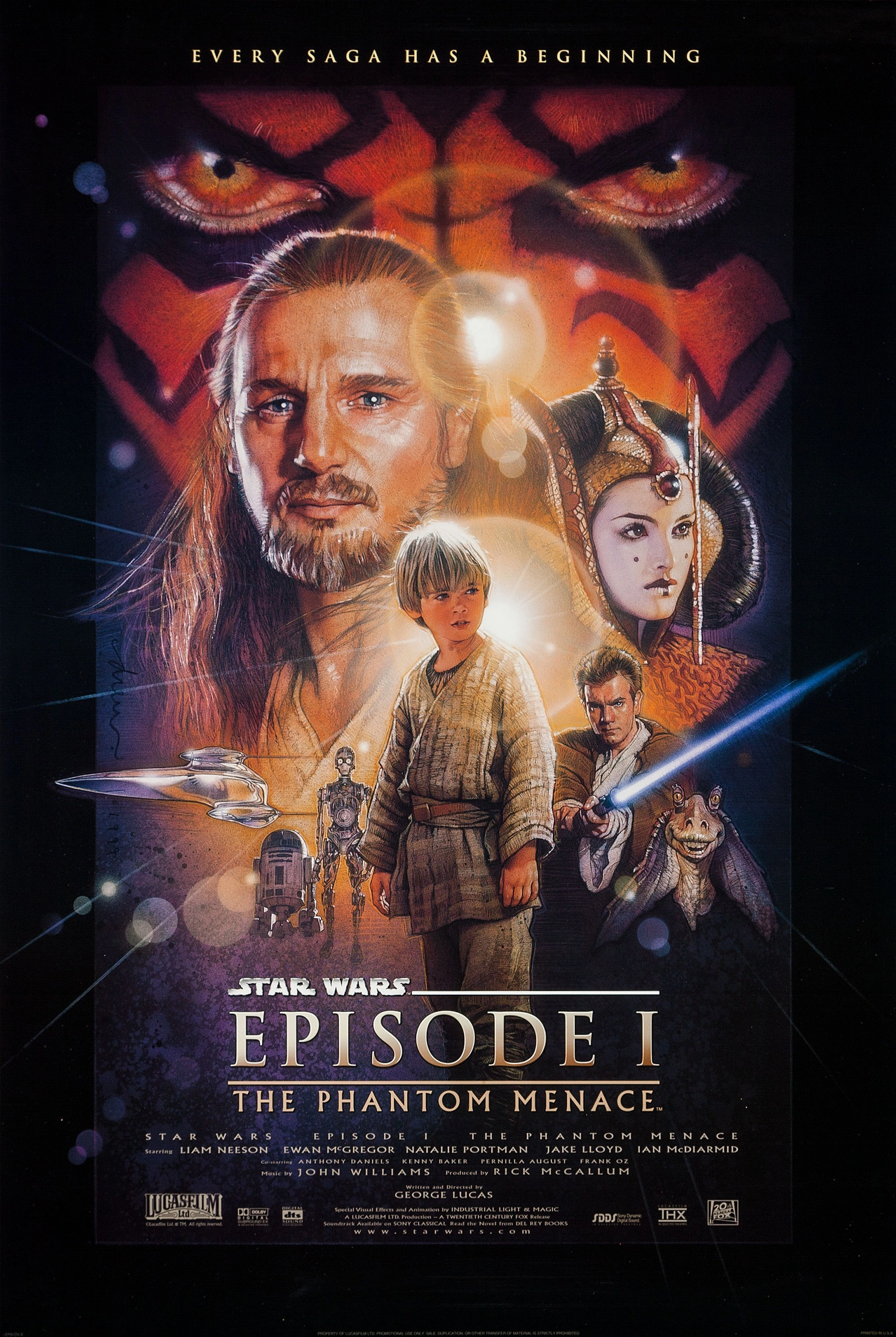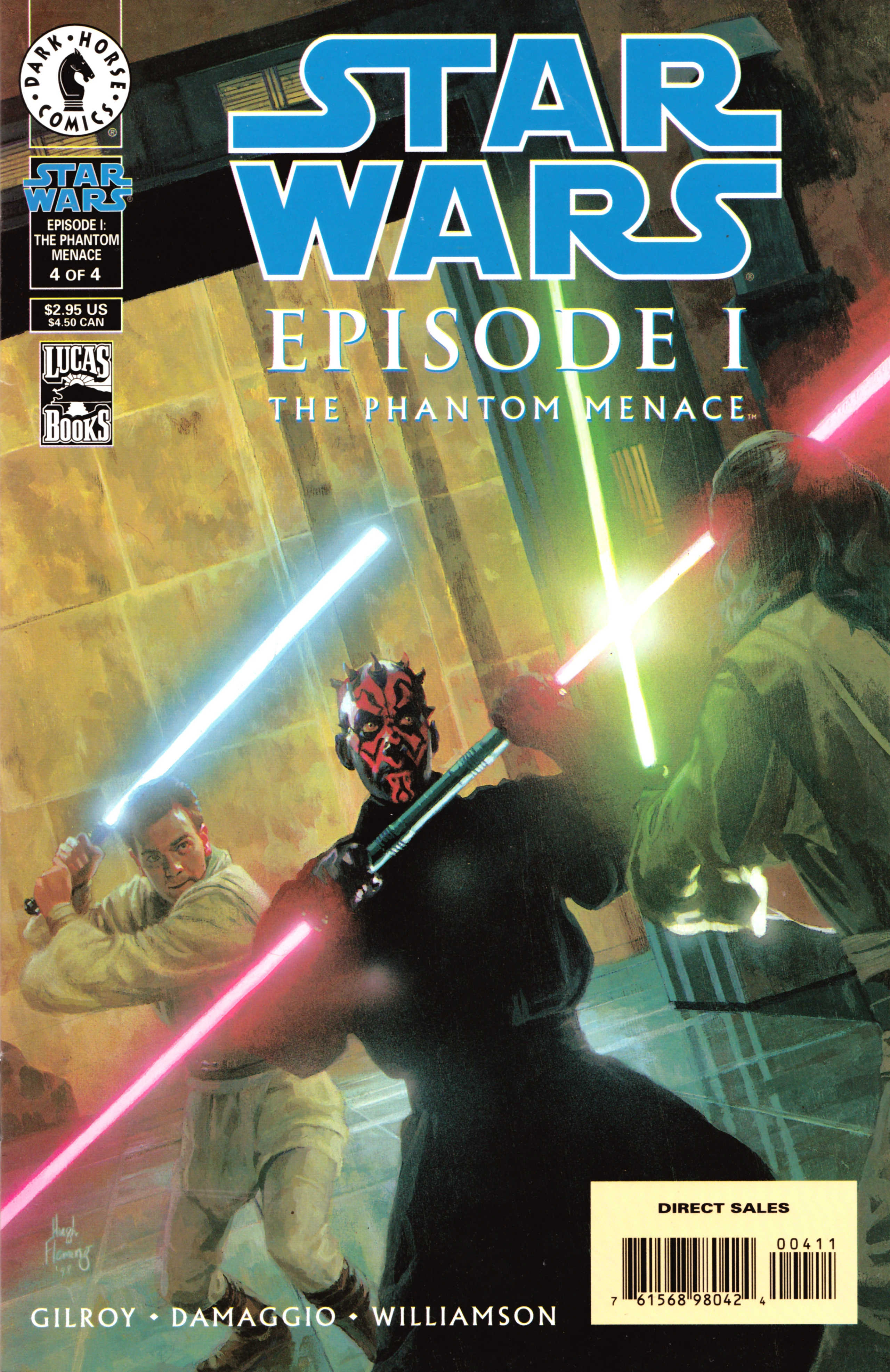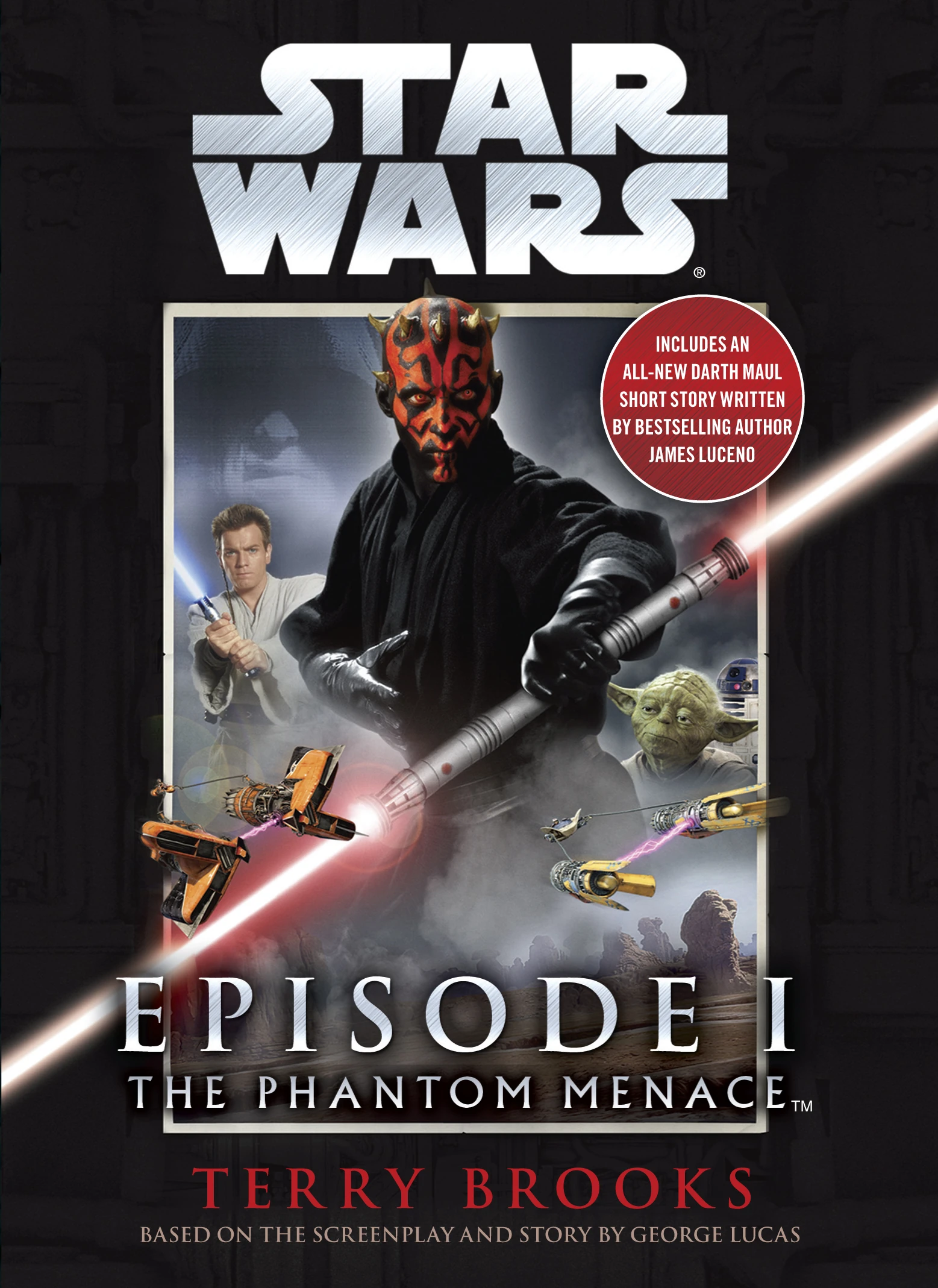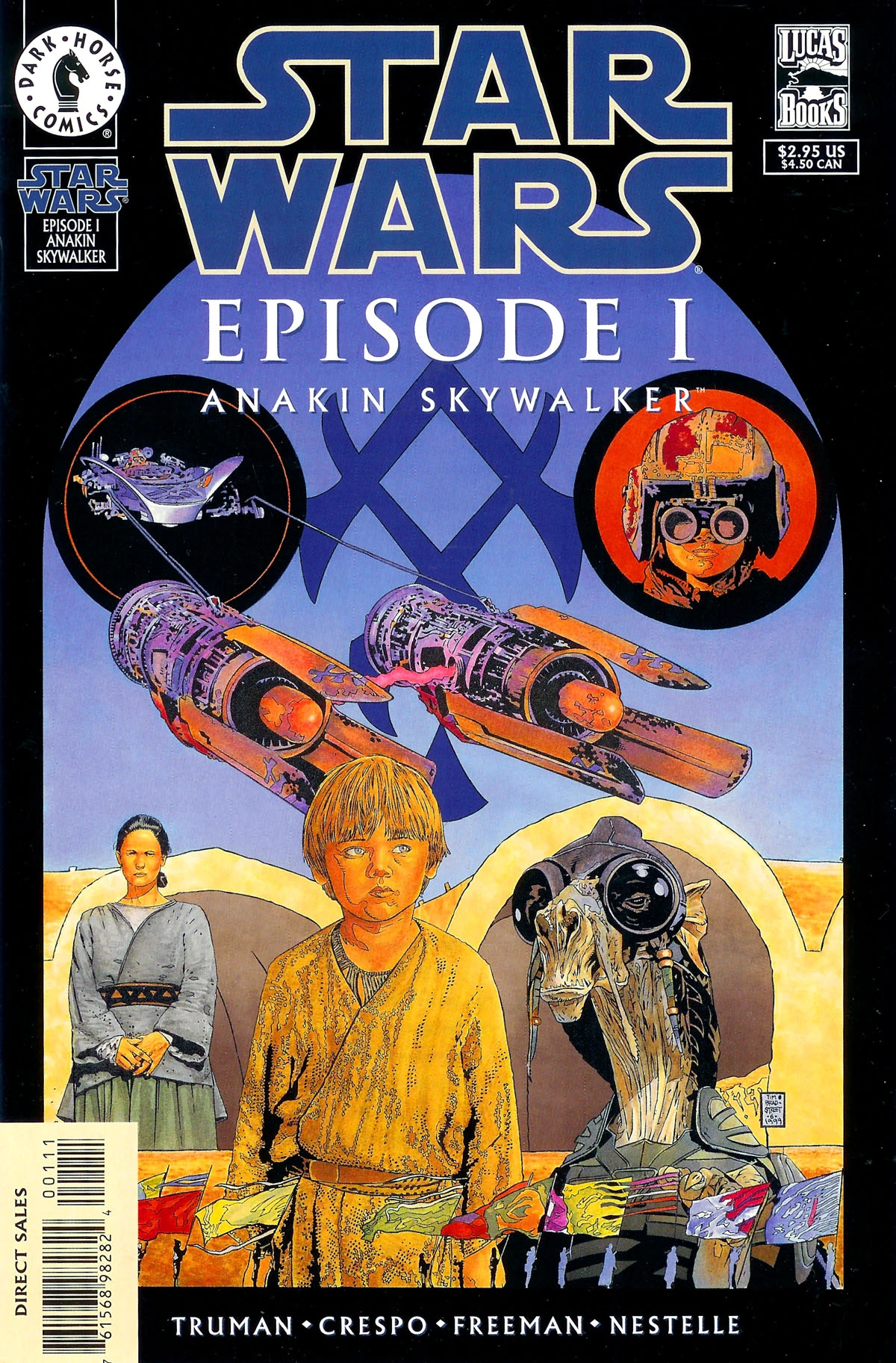I've read all published Star Wars Legends stories taking place in the days of the Old Republic and even earlier, depicting ancient wars between the Jedi and Sith. I've read the stories of the Sith transformation, permitting them to survive extinction and build their strength for an ultimate return. I've read the stories that set the stage for the first of the Star Wars movie prequels. Now: I start the movie era.
Episode I: The Phantom Menace came out in mid-May 1999, less than two weeks before my 13th birthday. I don't remember the exact date I saw it, but I believe it was late June, just after school ended. I seem to remember seeing it with my older sister when I spent a week visiting her after school was over. Unlike many Star Wars fans I only ever saw it in theatres once (seeing a movie multiple times in theatres wasn't something I did back then, though I did see the theatrical re-release in 3D in 2012). I don't remember being bothered by the things that annoyed other people. I remember the awesome lightsaber fight, the podrace, and the battles on land and in space. I was getting too old for many Star Wars toys at this point, but definitely got several Episode I Lego sets (Anakin's podracer, Darth Maul's ship, the Naboo fighter, and the Gungan submarine).
I only became jaded about the more annoying aspects, like Jar Jar Binks or kid Anakin, when I was a bit older. Perhaps I was influenced by negative reviews. I find that I'm often able to get past what I might call "objective problems" with a movie (legitimate reasons why most people would not like it) and enjoy it simply for the entertainment value.
For this post, I watched, read, or played the following:
Follow @C_Andrew_H
 |
| Movie poster for Episode I. Image from Wookieepedia. |
I only became jaded about the more annoying aspects, like Jar Jar Binks or kid Anakin, when I was a bit older. Perhaps I was influenced by negative reviews. I find that I'm often able to get past what I might call "objective problems" with a movie (legitimate reasons why most people would not like it) and enjoy it simply for the entertainment value.
For this post, I watched, read, or played the following:
- Episode I: The Phantom Menace (film by George Lucas, 1999)
- Episode I: The Phantom Menace (novel by Terry Brooks, 1999)
- Episode I: The Phantom Menace 1-4 (comic by Henry Gilroy, 1999)
- Episode I: The Phantom Menace 1/2 (comic by Tim Truman, Henry Gilroy, Ryder Windham, and Mark Schultz, 1999)
- Episode I: The Phantom Menace: Anakin Skywalker (comic by Tim Truman, 1999)
- Episode I: The Phantom Menace: Queen Amidala (comic by Mark Schultz, 1999)
- Episode I: The Phantom Menace: Qui-Gon Jinn (comic by Ryder Windham, 1999)
- Episode I: The Phantom Menace: Obi-Wan Kenobi (comic by Henry Gilroy, 1999)
- Galactic Battlegrounds, second and third campaigns, except for the alt-history final missions (video game by Ensemble Studios and LucasArts, 2001)
- Episode I: Battle for Naboo (video game by Factor 5, 1999)
- Episode I Racer (video game by LucasArts, 1999)
- Podracing Tales (webcomic by Ryder Windham, 2000)
I watched Episode I on blu-ray, read the second edition paperback of the novelization, and read the comic adaptation in Omnibus: The Complete Saga. The four one-shot comics and Episode I 1/2 (which was mixed in among the one-shots) were in Omnibus: Emissaries and Assassins. I played Galactic Battlegrounds and Episode I Racer on my PC (purchased from GOG.com), and watched a Let's Play video of Battle for Naboo. The Podracing Tales webcomic was in Omnibus: Wild Space Volume 2.
A reminder that the Episode I movie falls into both the Canon and Legends timelines. I'm treating the novelization and other adaptations as Legends only.
Episode I: The Phantom Menace opens with a fleet of Trade Federation battleships blockading the planet Naboo, for reasons having to do with taxation of trade routes (see Cloak of Deception). After two Jedi Knights, Qui-Gon Jinn and Obi-Wan Kenobi, fail to find a diplomatic solution and are ordered killed by Sith Lord Darth Sidious (who secretly ordered the blockade), the Trade Federation invades Naboo. The Jedi escape the planet with Queen Amidala, her retinue, and native Gungan Jar Jar Binks. Their ship is damaged, and they seek repairs on the desert world Tatooine. Junk dealer Watto has the necessary parts to fix their ship, but the Jedi has no acceptable currency. They befriend Watto's slave, a boy named Anakin Skywalker, who built his own podracer. Qui-Gon and Watto agree to sponsor Anakin in the next day's race, where Watto gets all winnings minus the cost of the parts Qui-Gon needs. They also wager Anakin's freedom on whether he will win. The boy does win, and is freed. He joins the Queen's retinue to go to Coruscant and plead for Republic support. As the Senate refuses to intervene, Amidala calls for a vote of no confidence in Supreme Chancellor Valorum, permitting Naboo Senator Palpatine to be elected chancellor (see Cloak of Deception and Darth Plagueis). Qui-Gon, meanwhile, requests that Anakin be trained as a Jedi, as he believes the boy to be the Chosen One, birthed by the Force to bring balance. The Jedi Council will not train him, but sends the two Jedi to accompany the Queen back to Naboo. Queen Amidala allies herself with the Gungan people, who amass an army in the grassy plains outside of the capital city of Theed. This distracts the Trade Federation army and permits a small team to capture the Trade Federation's viceroy. Qui-Gon and Obi-Wan face off against Darth Maul, the menacing apprentice of Darth Sidious. Qui-Gon is killed in the fight, but Obi-Wan manages to bisect his Sith foe. With the Trade Federation routed, there is a new peace on Naboo, and the Jedi Council agree to let Obi-Wan train Anakin. The Jedi now realize that the Sith have survived, but they are uncertain whether they killed the Sith Master or Sith Apprentice (for always two there are).
The second campaign of Galactic Battlegrounds is from the perspective of the Trade Federation. We see in the movie that the Trade Federation lands its troops on Naboo and immediately conquers the planet, but the first four missions of this campaign depict a longer war to control Naboo. Subsequent missions entail the search for and elimination of Gungan cities. The third campaign is from the point-of-view of the Gungans, beginning with several ancient battles to unite the Gungan tribes, and then skipping forward to the present war against the Trade Federation. Both campaigns also present "What If" missions of whether certain battles went differently (in the interest of time, I did not play these non-canon battles to completion).
In Battle for Naboo, you play as Gavin Sykes, a member of the Naboo Royal Security Force who retreats to the wilderness when the Trade Federation invades and participates in resistance action against the droid army, piloting a variety of Naboo fighters and speeders, as well as some captured Trade Federation vehicles.
Episode I Racer has no story and is completely non-canon, but I wanted to play it anyway. You play as one of the podracers (a few are permitted at the start, and more are unlocked as you play) and you race on different tracks across the Galaxy.
Podracing Tales was a webcomic that told a variety of stories featuring many of the characters who flew in the podrace sequence. It ends with everyone's surprise when Anakin wins the race. Much of the story is narrated by the two-headed race commentator.
Per my most recent post, I plan to take a short break from Star Wars before reading the Battlefront books. I don't want to go years before I read another non-Star Wars book. Therefore, my next post will discuss a handful of unrelated books and comics.
A reminder that the Episode I movie falls into both the Canon and Legends timelines. I'm treating the novelization and other adaptations as Legends only.
Story:
Episode I: The Phantom Menace opens with a fleet of Trade Federation battleships blockading the planet Naboo, for reasons having to do with taxation of trade routes (see Cloak of Deception). After two Jedi Knights, Qui-Gon Jinn and Obi-Wan Kenobi, fail to find a diplomatic solution and are ordered killed by Sith Lord Darth Sidious (who secretly ordered the blockade), the Trade Federation invades Naboo. The Jedi escape the planet with Queen Amidala, her retinue, and native Gungan Jar Jar Binks. Their ship is damaged, and they seek repairs on the desert world Tatooine. Junk dealer Watto has the necessary parts to fix their ship, but the Jedi has no acceptable currency. They befriend Watto's slave, a boy named Anakin Skywalker, who built his own podracer. Qui-Gon and Watto agree to sponsor Anakin in the next day's race, where Watto gets all winnings minus the cost of the parts Qui-Gon needs. They also wager Anakin's freedom on whether he will win. The boy does win, and is freed. He joins the Queen's retinue to go to Coruscant and plead for Republic support. As the Senate refuses to intervene, Amidala calls for a vote of no confidence in Supreme Chancellor Valorum, permitting Naboo Senator Palpatine to be elected chancellor (see Cloak of Deception and Darth Plagueis). Qui-Gon, meanwhile, requests that Anakin be trained as a Jedi, as he believes the boy to be the Chosen One, birthed by the Force to bring balance. The Jedi Council will not train him, but sends the two Jedi to accompany the Queen back to Naboo. Queen Amidala allies herself with the Gungan people, who amass an army in the grassy plains outside of the capital city of Theed. This distracts the Trade Federation army and permits a small team to capture the Trade Federation's viceroy. Qui-Gon and Obi-Wan face off against Darth Maul, the menacing apprentice of Darth Sidious. Qui-Gon is killed in the fight, but Obi-Wan manages to bisect his Sith foe. With the Trade Federation routed, there is a new peace on Naboo, and the Jedi Council agree to let Obi-Wan train Anakin. The Jedi now realize that the Sith have survived, but they are uncertain whether they killed the Sith Master or Sith Apprentice (for always two there are). |
| Cover of Episode I: The Phantom Menace #4, depicting the duel between the Jedi and Darth Maul. Image from Wookieepedia. |
 |
| Scene from the final canonical battle in the Gungan campaign of Galactic Battlegrounds. Image from Wookieepedia. |
In Battle for Naboo, you play as Gavin Sykes, a member of the Naboo Royal Security Force who retreats to the wilderness when the Trade Federation invades and participates in resistance action against the droid army, piloting a variety of Naboo fighters and speeders, as well as some captured Trade Federation vehicles.
Episode I Racer has no story and is completely non-canon, but I wanted to play it anyway. You play as one of the podracers (a few are permitted at the start, and more are unlocked as you play) and you race on different tracks across the Galaxy.
Podracing Tales was a webcomic that told a variety of stories featuring many of the characters who flew in the podrace sequence. It ends with everyone's surprise when Anakin wins the race. Much of the story is narrated by the two-headed race commentator.
Thoughts:
Let me begin by saying that I enjoy this movie. I understand that it has weaknesses, and there are some things that could have been done much better, but I still have fun watching Episode I: The Phantom Menace. If I made the movie, Anakin would be older (maybe 12 instead of 9) and Jar Jar would not be so annoying. Darth Maul would have more screen time. One idea I heard from the Star Wars Minute podcast was to have Jar Jar, Watto, and the Neimoidians speak alien languages and have subtitles, which might make them seem less silly and reduce or eliminate connections to racial stereotypes for which they are criticized. But when watching the movie, I have an insane amount of fun. I bury my annoyance at Jar Jar -- who is there to entertain young kids, not me -- and instead have fun with the lightsaber fights, the podrace sequence, the starfighter battle, and the droid army vs. the Gungans.
Episode I is my second-least-favourite Star Wars movie. My ranking, at time of writing, is 4-5-Rogue One-7-8-Solo-2-6-1-3. But even my least favourite Star Wars movies I rank at a 7/10 for entertainment value.
As with Rogue One, the novelization and comic adaptations add some more interesting details. The novel includes several scenes with Anakin on Tatooine before the main characters arrive (including his previous podrace, in which his rival made him crash and destroy Watto's podracer.) We also learn that Qui-Gon Jinn was meant to be almost 60 years old, though Liam Neeson, at time of filming, was in his mid-40s. Star Wars characters are often said to be different ages than they look, either older (sci-fi worlds have advanced medical technology, permitting slower aging) or younger (harsh conditions on certain planets age someone rapidly).
The novel also answers some questions I had, such as "why did Qui-Gon bring Jar Jar with him on Tatooine, rather than leave him on the ship?" Answer: to make his team look more diverse, as multiple species working together is the standard on Tatooine. Also answered is "if Watto believed that Anakin's podracer was about the value of a slave (for betting purposes), why could Qui-Gon not have -- after the race -- traded the pod for Anakin's mother's freedom?" Answer: the cash value of the pod was not nearly enough to free Shmi Skywalker, and Watto valued the prestige he had on Tatooine from being a slave owner. I appreciate when novelizations answer these questions that are not technically plot holes, but take viewers out the story.
Finally, and while I understand this was unintentional, there's a scene in the novel where I like to think Jar Jar gave Anakin his pro-dictatorship views. Anakin and Jar Jar watch the Senate proceedings on a tablet, and while Anakin is hopeful the Senate will side with the Naboo, Jar Jar says that agreement is basically impossible when dealing with that many people. Ten years later, in Episode II, Anakin tells Padmé that, when politicians disagree, someone powerful should make them agree.
There were no new insights in the comic adaptation, but the four one-shot comics (collectively referred to as Episode I Adventures) add some additional details, including some conversations between the podracers, a Padmé and Jar Jar adventure before the podrace, and a retold version of the movie's story from Obi-Wan's point of view.
There is still one issue that no adaptation seems to have resolved. Queen Amidala and her contingent arrive on Tatooine in a luxury spaceship that happens to have a broken engine. Despite the damage, Watto thinks it's valuable. Why then could they have not tried to trade it in for a smaller, uglier ship that had working engines? Or use it to pay for a charter? All they needed was to get to Coruscant; they didn't need to do so in luxury.
Podracing Tales added some fun backstory to the podracer pilots, and I enjoyed reading it. It is, however, a bit of fluff that need not be sought out. Marvel opted not to collect this story in its recent Epic Collections, and Dark Horse Comics only printed it in their "Wild Space" omnibus (a catch-all for lost stories that don't fit elsewhere). That omnibus is long out of print, though you can buy a digital copy on Comixology.
Video game adaptations of key battles are fun, and I'm glad I got to experience the invasion and liberation of Naboo in Galactic Battlegrounds, Battle for Naboo, and the end of Starfighter. These battles are often portrayed a bit differently in the games than in the movies, but usually it's fairly consistent. Other sources occasionally make reference to the video game stories; the Darth Maul short story End Game referenced the Trade Federation campaign in Galactic Battlegrounds, for example. We know a lot must happen behind the scenes in these stories, and it's fun to pilot one of many fighters during the space battle above Naboo or getting to deploy the droid armies of the Trade Federation before they finish conquering Naboo. And racing around a podrace track is an exhilarating experience whether or not it is in continuity.
With Episode I complete, I now move firmly into the prequel era, with stories of various Jedi, including Obi-Wan and Anakin, on adventures prior to the Clone Wars. This period also features the adventures of bounty hunters like Jango Fett and Zam Wesell, laying the groundwork for Episode II. My next Legends post will focus on a variety of Jedi stories following Episode I, including 13 issues of Republic, the video game Obi-Wan, and the novel Rogue Planet. But first, I will jump back to the New Canon to read stories pertaining to the Battlefront video games.Episode I is my second-least-favourite Star Wars movie. My ranking, at time of writing, is 4-5-Rogue One-7-8-Solo-2-6-1-3. But even my least favourite Star Wars movies I rank at a 7/10 for entertainment value.
As with Rogue One, the novelization and comic adaptations add some more interesting details. The novel includes several scenes with Anakin on Tatooine before the main characters arrive (including his previous podrace, in which his rival made him crash and destroy Watto's podracer.) We also learn that Qui-Gon Jinn was meant to be almost 60 years old, though Liam Neeson, at time of filming, was in his mid-40s. Star Wars characters are often said to be different ages than they look, either older (sci-fi worlds have advanced medical technology, permitting slower aging) or younger (harsh conditions on certain planets age someone rapidly).
The novel also answers some questions I had, such as "why did Qui-Gon bring Jar Jar with him on Tatooine, rather than leave him on the ship?" Answer: to make his team look more diverse, as multiple species working together is the standard on Tatooine. Also answered is "if Watto believed that Anakin's podracer was about the value of a slave (for betting purposes), why could Qui-Gon not have -- after the race -- traded the pod for Anakin's mother's freedom?" Answer: the cash value of the pod was not nearly enough to free Shmi Skywalker, and Watto valued the prestige he had on Tatooine from being a slave owner. I appreciate when novelizations answer these questions that are not technically plot holes, but take viewers out the story.
 |
| Cover of second edition paperback of Episode I novelization. Image from Wookieepedia. |
There were no new insights in the comic adaptation, but the four one-shot comics (collectively referred to as Episode I Adventures) add some additional details, including some conversations between the podracers, a Padmé and Jar Jar adventure before the podrace, and a retold version of the movie's story from Obi-Wan's point of view.
 |
| Cover of Episode I: Anakin Skywalker. Image from Wookieepedia. |
Podracing Tales added some fun backstory to the podracer pilots, and I enjoyed reading it. It is, however, a bit of fluff that need not be sought out. Marvel opted not to collect this story in its recent Epic Collections, and Dark Horse Comics only printed it in their "Wild Space" omnibus (a catch-all for lost stories that don't fit elsewhere). That omnibus is long out of print, though you can buy a digital copy on Comixology.
Video game adaptations of key battles are fun, and I'm glad I got to experience the invasion and liberation of Naboo in Galactic Battlegrounds, Battle for Naboo, and the end of Starfighter. These battles are often portrayed a bit differently in the games than in the movies, but usually it's fairly consistent. Other sources occasionally make reference to the video game stories; the Darth Maul short story End Game referenced the Trade Federation campaign in Galactic Battlegrounds, for example. We know a lot must happen behind the scenes in these stories, and it's fun to pilot one of many fighters during the space battle above Naboo or getting to deploy the droid armies of the Trade Federation before they finish conquering Naboo. And racing around a podrace track is an exhilarating experience whether or not it is in continuity.
 |
| Box art for Battle for Naboo and Episode I Racer for the Nintendo 64. Images from Wookieepedia. |
Next:
Per my most recent post, I plan to take a short break from Star Wars before reading the Battlefront books. I don't want to go years before I read another non-Star Wars book. Therefore, my next post will discuss a handful of unrelated books and comics.
Follow @C_Andrew_H
Comments
Post a Comment